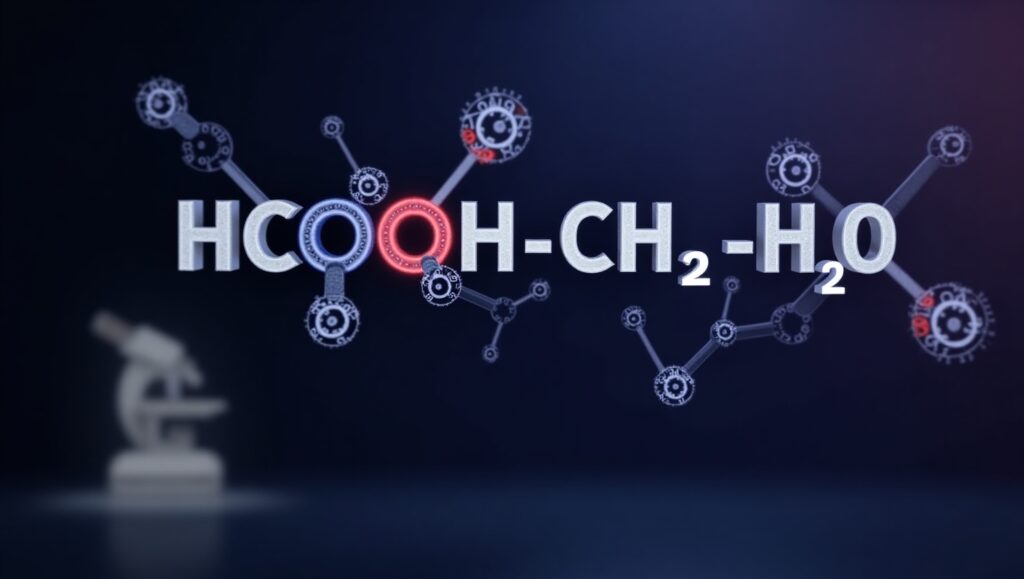HCOOCH CH2 H2O a compound shrouded in intrigue and rich with implications for our understanding of ester hydrolysis. In a world where chemistry can seem daunting, this seemingly cryptic notation invites us into a fascinating realm where organic compounds react, transform, and reveal their hidden stories. Join us as we demystify this enigmatic equation, explore the fundamental principles of ester hydrolysis, and discover how these processes influence everything from the flavor profiles in your favorite foods to critical applications in pharmaceuticals. Get ready to dive deep into the molecular dance, a complex and captivating phenomenon.
Introduction
Have you ever come across the intriguing formula HCOOCH2CH2O and wondered what it truly means? This chemical notation holds significant importance in the world of ester hydrolysis, a process that plays a crucial role in both nature and industry. Understanding this compound can unlock insights into how esters behave when they interact with water. Whether you’re a chemistry enthusiast or just curious about the science behind everyday reactions, unraveling the mystery of HCOOCH CH2 H2O is sure to enhance your appreciation for these fascinating processes. Join us as we dive into its structure, dispel some common myths, and explore why understanding this relationship matters more than you might think!
The chemical structure of HCOOCH CH2 H2O and how it relates to ester hydrolysis
HCOOCH2CH2O represents a fascinating interplay of chemical components. At its core, this molecular structure highlights the connection between formic acid and an alcohol, which is crucial in ester formation.
In ester hydrolysis, water (H2O) plays a vital role. When written clearly, such as HCOOCH2OH + H2O, it’s easy to see how water reacts with the ester. Here, HCOOCH2OH is the ester being decomposed in the presence of water, resulting in the formation of an acid and alcohol.
The carbonyl group (C=O) in the ester notation HCOOCH2OH is highly reactive toward nucleophiles like water molecules. This reactivity leads to bond cleavage, resulting in the production of an acid (e.g., formic acid) and an alcohol (e.g., methanol or ethanol), depending on the specific structure.
Understanding this structure helps demystify how esters behave under different conditions. By grasping these relationships at a molecular level, chemists can more accurately predict outcomes in various reactions involving ester hydrolysis.
Common misconceptions about HCOOCH CH2 H2O and the hydrolysis reaction
Many people assume that HCOOCH2CH2O2 is a simple compound, but this ester is more complex than it appears. This chemical often leads to confusion regarding its role in ester hydrolysis. One common misconception is that this compound only exists as a static entity. In reality, it’s dynamic and actively participates in the hydrolysis process.
Some believe water is just a bystander, but it is essential in the reaction between acids and alcohols.
Lastly, many learners overlook the crucial role of pH levels during this interaction. A neutral environment can yield different results compared to acidic or basic conditions, significantly influencing product formation.
Exploring the correct representation of ester hydrolysis and its products
Ester hydrolysis is a fascinating chemical reaction. It involves breaking down esters into their component parts: an alcohol and an acid. When water interacts with the ester, it triggers this transformation. The process can be catalyzed by acids or bases, influencing the reaction rate and efficiency. Each approach has its own nuances.
The products formed during hydrolysis depend on the specific ester involved. For instance, methyl acetate yields methanol and acetic acid upon hydrolysis. This specificity highlights how different starting materials lead to varied outcomes.
Understanding these products is crucial for applications across various fields, including food science, pharmaceuticals, and biofuels. Accurate representation of these reactions not only aids in academic pursuits but also enhances practical implementations in industry settings.
The importance of understanding the correct terminology in chemistry
Chemistry uses specific terms and symbols to communicate complex ideas. Correct terminology is essential for clear communication among chemists. Misunderstandings can lead to errors in experiments or misinterpretations of research. A single misplaced word can change the meaning entirely, significantly impacting outcomes.
Learning correct terms aids understanding. It also facilitates more productive discussions and helps individuals read scientific literature with confidence. Accurate terminology enhances interdisciplinary collaboration by establishing a shared vocabulary among chemists, biologists, physicists, and engineers.
In educational settings, focusing on precise language helps learners grasp foundational concepts. This clarity paves the way for innovation by ensuring everyone is on the same page when exploring new theories or applications in chemistry.
Real-world applications of ester hydrolysis and its impact on various industries
Ester hydrolysis is used in the production of biodegradable plastics, which break down into safe byproducts. In the food industry, ester hydrolysis plays a crucial role in the development of flavor. The process releases aromatic compounds from esters naturally present in fruits and other foods, enhancing taste and aroma. Additionally, pharmaceuticals benefit from ester hydrolysis during the drug synthesis process. Many medications are esters that require hydrolytic reactions to activate their therapeutic properties.
The agricultural sector also utilizes this reaction for developing pesticides and herbicides. Hydrolysis helps ensure that these chemicals break down safely after use, thereby reducing their environmental impact. From cosmetics to detergents, understanding ester hydrolysis unlocks opportunities for innovation across various fields while promoting sustainability. This underscores its vital importance beyond just theoretical chemistry.
Conclusion
Understanding HCOOCH2CH2O is crucial because it exemplifies the core thesis: the way specific chemical structures drive the mechanisms and applications of ester hydrolysis. This compound illustrates how the details of chemical transformations provide a window into both scientific comprehension and industrial progress.
The structure and function of HCOOCH2CH2O illustrate key concepts within this reaction mechanism. Recognizing its role can help demystify common misconceptions surrounding ester hydrolysis. Clarity in terminology enhances communication among chemists and students alike.
Ester hydrolysis has significant implications across various industries, from food production to pharmaceuticals. By appreciating the details surrounding compounds like HCOOCH2CH2H2O, professionals can drive innovation and efficiency in their fields.
Recognizing the significance of these chemical reactions not only enriches academic knowledge but also fuels practical applications that impact our daily lives. Understanding this connection propels us into a future where chemistry will continue to play a pivotal role in advancing technology and industry.

